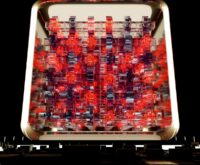A Deep Dive into LiDAR Technology and Its Applications
Ever wondered how self-driving cars “see” the world? Or how archaeologists uncover hidden cities beneath dense jungle canopies? The answer, in many cases, is LiDAR – Light Detection and Ranging. This incredible technology is revolutionizing industries from automotive to forestry, offering a level of detailed 3D mapping previously unimaginable.
What is LiDAR?
LiDAR works by emitting pulsed laser light and measuring the time it takes for those pulses to return after reflecting off objects. Think of it as a supercharged version of sonar, but using light instead of sound. By analyzing the time of flight and the wavelength shift of the returned light, LiDAR systems can create incredibly precise 3D point clouds, representing the shape and distance of objects in the scanned environment.

Key Components of LiDAR Systems
- Laser Scanner: The heart of the system, emitting the laser pulses.
- Scanning Mechanism: Directs the laser beam across the target area.
- Photodetector and Receiver: Captures the returning light pulses.
- GPS/INS: Provides location and orientation data for accurate georeferencing.
- Data Acquisition and Processing Unit: Records and processes the collected data to create the point cloud.
How Does LiDAR Differ from Other 3D Mapping Technologies?
While other technologies like photogrammetry and radar also create 3D maps, LiDAR stands out due to its higher accuracy, density of data points, and ability to penetrate vegetation. This makes it ideal for applications requiring high-precision measurements and detailed surface models.
Exploring the Diverse Applications of LiDAR
LiDAR’s ability to generate highly accurate 3D representations of the world has opened doors to a plethora of applications across various industries:
Autonomous Vehicles
LiDAR enables self-driving cars to perceive their surroundings, identify obstacles, and navigate safely. By creating a real-time 3D map of the environment, LiDAR allows autonomous vehicles to “see” pedestrians, other cars, and road features with remarkable precision.
Archaeology and Cultural Heritage
LiDAR has revolutionized archaeology by allowing researchers to penetrate dense foliage and uncover hidden ruins. From ancient cities buried beneath jungles to forgotten landscapes, LiDAR reveals historical treasures without the need for extensive excavation.
Forestry and Agriculture
LiDAR helps monitor forest health, estimate timber volume, and manage crops effectively. By mapping tree heights, canopy cover, and biomass, LiDAR provides valuable insights for sustainable forestry practices and precision agriculture.
Urban Planning and Infrastructure
LiDAR plays a crucial role in urban planning, enabling accurate city modeling, infrastructure assessment, and disaster management. Creating detailed 3D models of cities allows for better planning of transportation networks, building development, and emergency response strategies.
Surveying and Mapping
LiDAR is widely used for creating highly accurate topographic maps, generating digital elevation models (DEMs), and monitoring land changes over time. Its precision and efficiency make it an invaluable tool for surveying and mapping applications.
“LiDAR’s ability to capture detailed 3D data is transforming how we interact with and understand the world around us.”
The Future of LiDAR Technology
The future of LiDAR is brimming with potential. Advancements in sensor technology, data processing algorithms, and integration with other technologies like artificial intelligence (AI) are paving the way for even more sophisticated applications.
- Smaller and more affordable sensors: This will make LiDAR accessible to a wider range of industries and applications.
- Real-time data processing and analysis: This will enable faster decision-making and enhanced capabilities for autonomous systems.
- Integration with AI and machine learning: This will unlock new possibilities for automated object recognition, scene understanding, and predictive analysis.
Conclusion
LiDAR technology is rapidly evolving, offering a powerful tool for understanding and interacting with the world around us. From self-driving cars to uncovering ancient ruins, LiDAR’s applications are vast and continue to expand. As the technology matures and becomes more accessible, we can expect even more groundbreaking discoveries and advancements in the years to come. LiDAR is not just mapping our world; it’s shaping our future.



 Tech & Travel: A Guide to Sustainable Tourism
Tech & Travel: A Guide to Sustainable Tourism  Wearable Medical Devices: The Future of Healthcare
Wearable Medical Devices: The Future of Healthcare  What is Ambient Computing? The Invisible Computer Guide
What is Ambient Computing? The Invisible Computer Guide  Future of Virtual Influencers: What’s Next for CGI Stars
Future of Virtual Influencers: What’s Next for CGI Stars  AI in Justice: The Ethical Dilemmas We Can’t Ignore
AI in Justice: The Ethical Dilemmas We Can’t Ignore  Wireless Charging Technology: How It Works & What’s Next
Wireless Charging Technology: How It Works & What’s Next  How Venture Capital is Shaping the Crypto Industry
How Venture Capital is Shaping the Crypto Industry  Sentiment Analysis for Crypto: A Trader’s Ultimate Guide
Sentiment Analysis for Crypto: A Trader’s Ultimate Guide  NFTs: The New Key to Membership & Brand Loyalty | Guide
NFTs: The New Key to Membership & Brand Loyalty | Guide  Polkadot’s Parachain Architecture Explained Simply
Polkadot’s Parachain Architecture Explained Simply  Crypto Phishing: How to Protect Your Digital Assets
Crypto Phishing: How to Protect Your Digital Assets  Social Media on Blockchain: The Next Digital Frontier
Social Media on Blockchain: The Next Digital Frontier